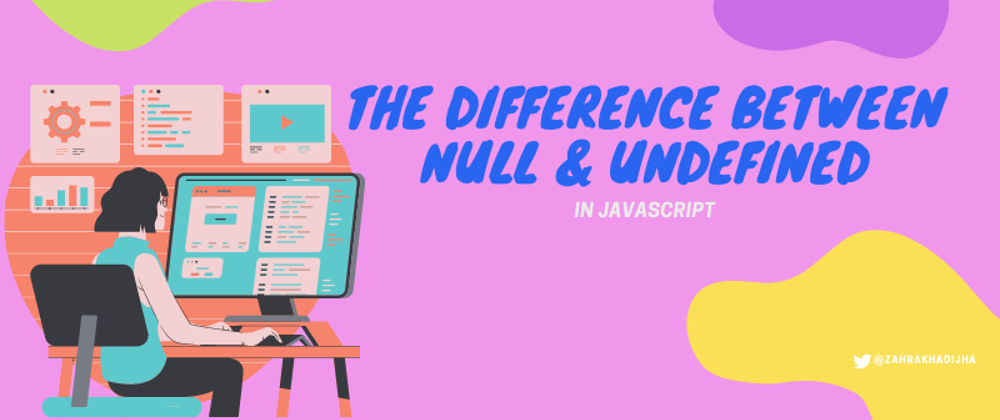Whenever I encounter null or undefined, I get incredibly confused by how each data type is used in JavaScript.
I mean, what's the difference? Don't they both express the concept of nothing?

I decided to do some research to gain a deeper understanding of the two data types. It's helpful to have this knowledge so that you can use them correctly when needed. I've also learned that sometimes, the difference between null and undefined comes up in interviews. 👀
Introduction
JavaScript has 7 primitive data types, two of which are null and undefined.
Null is an assignment value, which means that you can assign the value null to any variable when you want that variable to be empty. It is intentionally left blank and will point to an empty value.
let hasCat = null;
// nullish
Undefined is a variable that exists but hasn't been initialized YET. Which means that later, I can come back to my variable and assign it a value that it did not have before. So if I declare a variable without a value, it's just considered non-initialized.
let currentJob;
// undefined
The way that I understood both of them is that, yes, they are both very similar in that they both don't have a value that you're trying to access. If you were to compare the two in JavaScript, implicitly they're the same because JavaScript considers them both as empty values. But since they are both different data types, if you compare them explicitly, they will result in a falsey value.
null == undefined;
// truthy
null === undefined;
// falsey
Analogy
Imagine you're moving. You bought a bunch of boxes. You have to pack up your stuff and put them inside of those boxes. But you're disorganized so you forget to label what's in the boxes. You have 5 boxes that are full of things and you have 2 boxes that are left empty. You want to label your boxes but you've already put tape on them, so you tell yourself you'll come back to it later. For now the 5 boxes are TBD. And the 2 boxes are leftover and empty. In code, that would look like:
let fiveBoxes = undefined;
let twoBoxes = null;
The five boxes with a bunch of stuff in them are considered undefined because they have things in them but you don't know what's in it YET. The two boxes left empty are MEANT to not have anything in them.
Null vs. Undefined
The difference between the two data types is:
Undefined
- Declared
- Uninitialized
- Engine Assigned
Null
- Lack of
- Empty/void
- Non-existent
- User assigned
Go to your console, and type in:
typeof null
typeof undefined
What do you get?
Conclusion
Null and undefined are not the same. It's important to learn the difference between the two so you avoid any buggy behavior in your code and have a clear understanding of why they exist. It's also cool if you're able to clearly state the difference in an interview too 😉
Feel free to hit me up on Twitter if you're still confused! Or if you'd just like to chat.







Top comments (26)
What about
This is not the same, right? Also in the latest typescript it was implemented to differentiate these 2 cases.
I prefer
nullfor nullish values.This is incredible feedback and so good to learn!
Yeah I've watched some videos on the topic where it's best practice to use
undefinedovernullbut I love your explanation!Thank you!
One caveat about
undefined:An
undefinedvalue is inconclusive with regards to the existence of the property/element within an object/array.Also note that browser developer tools will mark "holes" in arrays with
empty.Chromium:
Firefox:
ECMAScript 6: holes in Arrays
The void operator returns
undefined.Null is a valid value to represent anything that is nullable in nature. Undefined means it does not exist because it’s unset and was never set.
Does a person have a middle name? If yes, it will have an alpha value. If they do not have a middle name, it would be null. This is to say that the actual value is deliberately meant to be no middle name. This differs from undefined which is to say that the value does not exist because it was unset. Perhaps the form to enter the person details was only partially completed. Undefined means no deliberate choice has been applied to it. Null differs, if you’re using it correctly.
Taking this further, let’s say your data store is Mongo. You started by only collecting first and last name, and have thousands of documents that are missing this field. Later, you decide to include a middle name. Null is still valid, because not everyone has a middle name. You decide that, in order to facilitate data collection, you want to prompt any existing users that are missing this field. You could prompt those that have not yet taken an action because you can clearly see that the field is missing/undefined. They may choose to acknowledge that they have no middle name, at which point you’d save null to the document.
Now you want to integrate with a third party web api. That third party system is written in a strongly typed language (Java or C#). They only have the notion of null. You have forgotten to send over this middle name field because of how js’s type system works, and because of how the deserializers work, they do not know whether to reject the request or not. After all, they default to null if the field is not present in the json payload. The system has now made an incorrect assumption because of a limitation between being able to discern whether the data should be there but wasn’t or whether it was there and was intended to be null. This problem exists because there’s only one null.
Undefined is metadata that describes a js value that’s integral to its duck typing system. It’s got an entirely different purpose than null.
If you work in the field, how long have you been at it?
Null and undefined are not the same and serve different purposes.
Note that var and let keywords let you make undefined but const does not
For bonus points, add a fallback for undefined or null or falsy (zero, empty string)
Or in newer versions of JS, you can use this to handle null and undefined, but it won't replace zero or empty string.
michaelcurrin.github.io/dev-cheats...
TypeScript can enforce missing values for you so you don't have to throw errors or use a fallback.
I didn't even consider const. Thank you for pointing that out!
I cannot effectively respond as I’m in my phone.
If you filled a form partially, you can just use undefined.
Yes, it would be undefined by default. That’s my point.
Both mean "nullish/empty/missing value", making the distinction between intentionally left empty or not makes no sense.
They do not because one requires an action to be applied. Intent rather than an assumption. Null does not mean a missing value in the way you are describing. That is expressly the purpose of undefined in js.
You're basically describing a poorly designed API/back-end. If you have a back-end that doesn't have the concept of an optional/undefined property, then you should acomodate for that. Front-end shouldn't be fixing issues of the back-end (which is a pretty common mistake).
First - and my main point - is to point out the flaw in those languages that happens to not exist in js because js actually got something right. But secondly, do you often have control over the third party systems you integrate with? 🤔
If the middleName field becomes required, then you could say that if it isn't a string, then it wasn't filled yet (undefined), and if is intentionally left empty, then is just an empty string "", again no need for null here.
Apply this to an integer. Do you fallback to zero as default? You’re being too narrow in your reading.
I'm not the only one that says this, if you don't want to take my word for it, maybe you'll take the word of Douglas Crockford (the author of "JavaScript: The Good Parts" and JSON) here.
I’m aware of him, and he is not infallible. This is an example.
I don't know how is my time in this field relevant, but if you really want to know, I been doing this for 10+ years
It’s relevant because you keep citing “real world examples”, yet are advocating for lossy handling of data. It makes no sense and does not fit well with practical experience, imo.
I agree 'Because when you use null you end up using both null and undefined, but when you use just undefined, you only check for one' I guess this is the main reason. Undefined is like optional for me and I never use null and undefined with different meaning in my code. I mean I don't have any example of code that treat it differently when having a variable or property with the type undefined or null. Thank to the strict option of typescript, I check every case.
Another fun difference:
Looks like you didn't read my post carefully. The point is, your point is WRONG.
number | booleanis NOT the same asnumber | null. You cannot give a WRONG alternative as a replacement. Also, again, you do NOT understand "states with precision". In many places,X | undefinedcould mean the same thing asX | nullif you do not require the precision. But when you need it,X | undefinedis NOT sufficient. You have to INVENT something, which is precisely why you gave the examples of-1andnumber | boolean. Both are WRONG. At least,number | "nothing"makes better sense!See. I told you. You do NOT understand states. Your example has a FOURTH state as well.
You think Haskell has
0nullish value?Maybeis exactly how Haskell implements a nullish value, or an absence of value, or a missing value. Just because it's spelled differently and accessed differently, does NOT mean it does not encapsulate the idea of nullish value. It's BETTER designed null.That's the first time I've heard this. Do you have any evidence to back this up?
To my mind the distinction between the two is quite clear:
undefined: no value has yet been assignednull: explicitly set to emptyIn practice I agree they're interchangeable, but occasionally it's useful to be able to distinguish between a value that hasn't been set and one that has been explicitly emptied.
Here you lost the argument! Because when you say
anInteger? : number | boolean, you are actually trying to distinguish "missing by default" from "intentionally not set". Now you can express that in many ways:All are equivalent now (well not really, not yours). You're simply choosing to "spell"
nulldifferently in each case. BTW, moreover, do you realizenumber | booleandoes not make much sense? Do you know why? THINK. Because now you can have:I'm sure you didn't mean that? That is what happens when you do not understand "states" with precision. When you want to have
3 states(likenumber,undefinedandnull(or"nothing"if you spell it differently), your suggestion introduced a bug and you end up having4 states.Real world scenarios, they mean entirely different things.
The more I learn about JavaScript's rich diversity of freedom the more I want to just stick with typescript.
Yeah I can't wait to learn Typescript properly!
Good point in other comment on filling in very common encounters of undefined as when getting a non-existent key from an object an getting undefined (in Ruby you get null and Python you get an error) and an argument that is not defined (Python will give an error when it is not defined but in JS you must validate yourself).
Also noteworthy for how to check for undefined.
Another use is to skip positional arguments by passing a value explicitly as undefined, assuming it is optional.
In Python this is not need as you can switch to keyword params.
I searched and didn't find much more than 'you can save some inconvenience by avoiding null' 🤷
I don't have a very strong opinion on this. I just hadn't seen anything that justified describing the use of null as bad practice. If there was I might have to speak to the backend devs I work with 😅